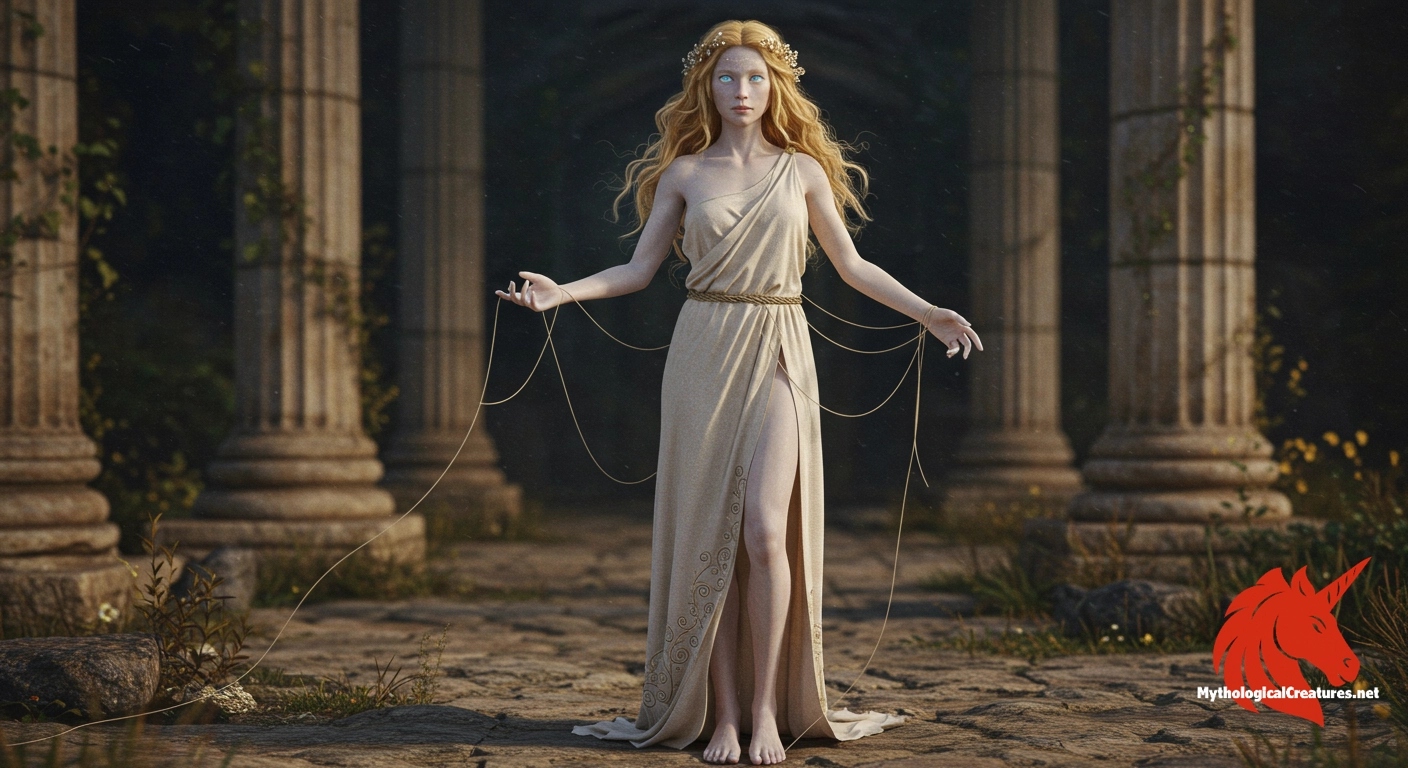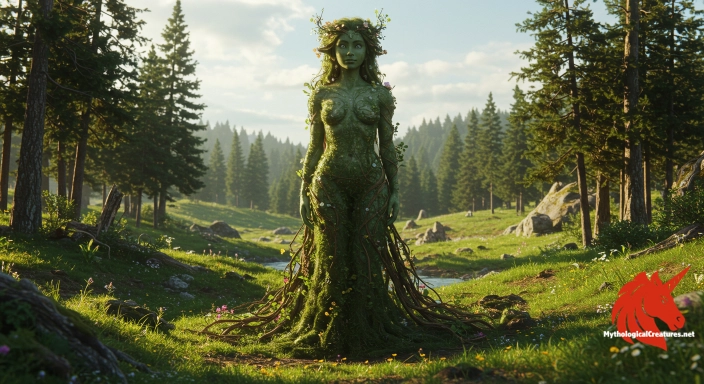Rhapso: Rhapso is a minor goddess or nymph from ancient Greek mythology, worshipped at Athens.

Rhapso
Rhapso - Represents the interconnectedness of life, fate, and the art of sewing, reflecting ancient Greek cultural values regarding birth and destiny.
Origins & First Encounters
Rhapso emerges as an enigmatic figure within the diverse tapestry of ancient Greek mythology, celebrated as both a nymph and a minor goddess in the Athenian pantheon. Attested primarily through a solitary inscription from the 4th century BCE discovered at Phaleron, her presence hints at a specialised cult within the vibrant religious milieu of classical Athens. Her name, derived from the Greek term meaning 'to sew' or 'to stitch', evokes a compelling image of a deity involved in the delicate art of mending life’s fabric. This distinctive characteristic positions her alongside the revered Moirai, whose function in orchestrating destiny was integral to Greek cosmology. Alternative interpretations link her with Eileithyia, thereby associating her with the mysteries of birth and the nurturing of life. The intertwining of these roles suggests that everyday activities such as sewing were imbued with profound spiritual significance. In the rich cultural context of Athens, where craftsmanship and domestic skill were celebrated, her divine function would resonate with both artisans and those seeking blessings in childbirth. Although her historical footprint is limited, each nuance of her character contributes to a broader narrative about the interconnectedness of fate, craft, and human experience. The enduring allure of Rhapso continues to captivate scholars and enthusiasts alike, inviting continual reinterpretation of her subtle yet meaningful presence.
Source Texts & Tale Variants
The primary source that attests to Rhapso’s existence is a singular inscription discovered at Phaleron dating from the 4th century BCE. Despite the scarcity of textual material, this inscription has served as a foundation for a range of interpretive narratives over subsequent generations. One popular variant of her myth positions her within the circle of the Moirai, depicting her as an active agent in organising the thread of a man’s life at birth. An alternative tradition casts her as a companion to Eileithyia, thereby emphasising her connection to the processes of childbirth and the nurturing of life. The limited documentation has led to a diversification in her myth, as oral traditions and later scholarly interpretations have sought to expand her role. The inscription operates as a pivotal point around which many speculative accounts of her divine attributes have been crafted. Although her story is fragmentary, the surviving evidence has inspired imaginative re-readings that blend elements of fate and domestic craftsmanship. This confluence of narrative strands highlights the fluid boundaries between myth, ritual practice, and daily life in ancient Athens. As a result, even the sparsest of sources has allowed Rhapso’s legacy to grow, underscoring the power of minimal evidence to generate profound mythological significance.
Form & Powers
Even though no surviving texts provide a detailed physical portrayal of Rhapso, creative reconstructions draw on the common attributes of Athenian nymphs and minor goddesses. It is plausible that she was envisioned as a figure of delicate beauty, exuding a gentle elegance and quiet authority. Imaginative depictions might have shown her with luminous, soft features that resonated with the aesthetic ideals of classical art. Her flowing hair could have symbolised the intertwining threads she was believed to handle, each strand representing an aspect of life’s fabric. Attire such as a diaphanous robe or peplos, subtly embroidered with intricate patterns reminiscent of stitching, would have accentuated her connection to the craft. In certain artistic interpretations, accessories like spindles or motifs of thread might have complemented her image, effectively linking her divine role with the daily act of sewing. The envisioned nuances of her posture and gesture likely balanced both the vulnerability inherent in the process of birth and the meticulous diligence of repairing a fabric. Variations in artistic expression might have allowed local painters and sculptors to imbue her with attributes that resonated with regional tastes. Although her form remains largely speculative, these visual reconstructions offer a bridge between tangible craft and the ethereal quality of divine influence.
Regional Faces
While Rhapso’s attested worship appears to have been rooted primarily in Athens and its environs, the potential for regional variation cannot be dismissed entirely. The Athenian focus on domestic arts and the celebration of craft provided a fertile ground for the veneration of a deity associated with sewing and fate. In nearby areas, similar minor divinities might have absorbed attributes of Rhapso, adapting her character to better suit local customs and traditions. Rural and coastal communities, where artisanal skills were held in high esteem, may have celebrated her through modest rites and festivals centered on the acts of creation and repair. The fluid nature of ancient religious practices often permitted a deity’s narrative to shift subtly between regions, integrating local cultural symbols. Despite the paucity of explicit evidence outside Athens, the broader Greek tradition supports the idea that regional adaptations were common among lesser-known deities. Such adaptations would have been expressed through distinctive ritual practices or iconographic choices that highlighted local values. Even a marginal presence in other communities could reflect the shared reverence for the crafts that sustain life and culture. Through these subtle differences, Rhapso’s myth continues to exemplify how divine figures could extend far beyond their original liturgical boundaries.
Cultural Parallels
Rhapso’s narrative offers intriguing parallels with other mythological figures whose roles encapsulate themes of fate, birth, and domestic craftsmanship. Her specialised function in organising the threads of life draws a striking comparison with Clotho, one of the Moirai, who was famed for spinning the very thread of destiny. In a similar vein, her associations with Eileithyia resonate with portrayals of goddesses who govern the natural and sacred processes of childbirth. Across the Mediterranean, figures such as the Roman Parcae also encapsulate these intertwined themes, symbolising the continuity of life through their roles in destiny and creation. The motif of weaving or stitching the fabric of human existence appears in various cultural traditions, including those of the Norse, where the Norns hold a comparable function. This convergence across mythologies underscores a widespread cultural impulse to sanctify the everyday practices of craft and creation. Modern reinterpretations often highlight these parallels in order to place Rhapso within a larger framework of divine symbolism across civilizations. Through comparative analysis, the seemingly mundane act of sewing acquires layers of meaning, bridging the mortal and the divine. Such cross-cultural connections emphasise the enduring human fascination with the mechanisms by which fate and life are interwoven.
Legacy & Modern Evolution
The evolution of Rhapso’s myth reflects the dynamic interplay between ancient traditions and modern reinterpretations. What began as a brief mention on a 4th century BCE inscription has gradually inspired a narrative that transcends its modest origins. Over time, her identity has been reimagined by scholars and artists who see in her the quiet power of domestic creativity and the mysterious workings of fate. Modern cultural expressions, from literary works to art installations, have often invoked her image as a symbol of the delicate balance between life’s fragility and its enduring continuity. The act of stitching, once seen purely as a domestic craft, has come to embody broader themes of repair, renewal, and interconnected destiny. Contemporary discussions frequently explore how minor deities like Rhapso reveal the hidden layers of ancient belief systems and the roles these beliefs play in modern identity. As reinterpretations of classical myths gain popularity, Rhapso serves as a reminder of the potency of even the most obscure mythological figures. Her story, though fragmentary in the historical record, has been expanded and enriched by the imaginative power of modern creativity. The revival of interest in lesser-known deities enriches our understanding of ancient cultures and their enduring influence on modern symbolism. Ultimately, Rhapso’s journey from an obscure Athenian inscription to a figure celebrated in modern myth-making underscores the timeless allure of the mystical and the artful.
Interesting Fact
The singular inscription of Rhapso not only underlines her obscure cult but also highlights the ancient Greek reverence for the art of sewing as a metaphor for weaving fate.
Quick Creature Info
Origin:
Features:
Associations:
Our Mythic Legendary Rating:

Habitat:
Supernatural Powers:
Physical Attributes:
Abilities:
Behavior:
Lore:
Related Creatures, Tales or Lore
References
Discover Another Mythical Legend You May Not Have Heard Of?
Uncover the mysteries of ancient folklore and expand your knowledge of legendary beings from cultures around the world.
Dare to Meet the Gaia....
Mythical Disclaimer: The images and data on this site are derived from various historical and literary sources, but we have found that many myths often have multiple versions and interpretations across references, sometimes contradictory. As a result, these creature depictions are artistic interpretations—imaginative blends of folklore, legend, and a dash of AI guesswork. Because creature descriptions vary widely, our illustrations and accompanying information represent our best effort to honor mythology while bridging creative gaps. Enjoy these interpretations—just remember, we've done our best to respect the stories and validate available data, but in the realm of mythology, details often shift, imagination leads the way, and nothing is ever set in stone!
Curated by the Mythological Creatures Team (rev. May 2025)
